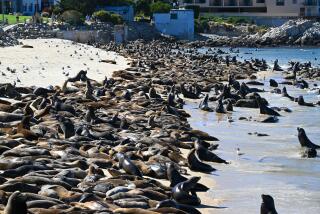Environment : Notes about your surroundings.
- Share via
A GUIDE TO MIGRATING BIRDS: As summer winds down, migrating birds begin to arrive from breeding grounds in the north. Some are just passing through to rest and feed, while others will spend their winter here in the county.
While migrating waterfowl and land birds have just started to trickle in and will peak later in the season, the shore bird migration is already in full bloom. A beginner birder armed with binoculars, sturdy shoes and a field identification guide (the National Geographic Society’s “Field Guide to the Birds of North America,” second edition, is generally regarded as the best) should be able to identify a variety of birds at the county’s premier coastal wetlands, the Upper Newport Bay and Bolsa Chica state ecological reserves.
Some common birds to look for:
SHORE BIRDS: The long-billed curlew is distinguished by its long, sharply downturned bill. It is a large bird, cinnamon brown above and buff below. Another large shore bird is the marbled godwit, with a long bi-colored bill that is usually upcurved. Both the willet and the greater yellowlegs, in comparison, have heavier, shorter bills; the easiest way to tell them apart is the color of their legs. The willet has gray legs and the yellowlegs has, as might be guessed, yellow legs.
Dowitchers are medium-size shore birds, dark in color with pale eyebrows. Both long-billed and short-billed dowitchers have long, straight bills--it can be difficult for beginners to tell them apart. Among the smallest of the local shore birds are western and least sandpipers. Western sandpipers are often seen in flocks that number in the thousands.
Plovers are compact birds that dart across the mud flats in sharp, sudden bursts. Among the species that can be spotted locally are the semipalmated, black-bellied and snowy plovers and the killdeer, with its distinctive double breast bands. Ruddy turnstones are marked by their black and white bibs and orange legs.
Finally, this is the best time to see two elegant shorebirds that will soon be moving to points farther south. The Wilson’s phalarope has a long, thin bill and dark stripe on the face and neck; the red-necked phalarope, with a shorter and thicker bill and a dark patch behind the eye. When feeding, phalaropes often spin like tops on the surface of the water to stir up crustaceans, insects and other potential meals.
WADING BIRDS: Three of the largest and most distinctive wading birds are seen here all year but are more abundant in fall. Often more than 3 feet tall, the great blue heron is hard to miss as it stands stock-still at the water’s edge. With their all-white plumage, the great egret (black legs and feet) and the snowy egret (black legs, yellow feet) are also prominent marsh residents.
The much smaller black-necked stilt and American avocet are common on the marsh.
ON THE BEACH: Shore birds that are more common on rocky and sandy beaches than on the mudflats of coastal wetlands are sanderlings (which are commonly seen darting in and out of the surf), wandering tattlers, black turnstones and surfbirds.
GULLS AND TERNS: There are about five locally common species of gull, but they can be hard for beginners to distinguish. The Heerman’s gull, with its white head and red beak, is distinctive.
Several varieties have just started to breed locally in recent years, but their numbers still swell dramatically in fall. Thousands of elegant terns can now be seen at Bolsa Chica; other species include Caspian and Forster’s terns and the large black skimmer, which feeds by dragging its lower bill in the water as it flies. The endangered California least tern, which breeds locally, has already moved south for the fall.
WATERFOWL: It is still early for migrating waterfowl, but several species should be trickling into local wetlands areas in the coming weeks. These include green-winged teals, northern pintails, widgeons, northern shovelers and several species of grebe.
TOURS: A good way for beginners to get an introduction to birds of the local wetlands is to take a tour. Amigos de Bolsa Chica offers free monthly tours in fall and winter; call (714) 897-7003 for information. Friends of Newport Bay also offers monthly tours; call (714) 646-8009. Finally, some tours offered by the local Sea and Sage chapter of the National Audubon Society are open to the public. Call (714) 543-7393.
More to Read
Sign up for Essential California
The most important California stories and recommendations in your inbox every morning.
You may occasionally receive promotional content from the Los Angeles Times.









